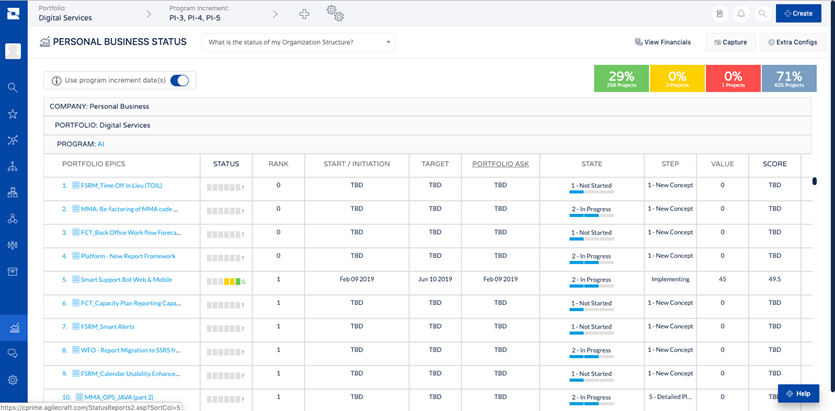Aligning the Agile Organization from the Executive Level with Jira Align
In a previous post, we introduced you to Jira Align — formerly known as AgileCraft — the newest addition to the Atlassian suite of solutions. We’re extremely excited about this powerful tool and its seamless integration with Jira and other applications so many of our clients rely on. So, we’re diving a bit deeper into Jira Align with a series of four articles focused on some of the key user roles:
- Product Manager
- Program Manager
- Portfolio Manager
- Executive
In each case, we’ll explore the day-to-day challenges these individuals often face during their enterprise agile journey, and how Jira Align provides satisfactory solutions to those problems.
The Tech Executive’s Role
We’ve already discussed the oversight and management responsibilities required at the product, program, and portfolio level. The executive role, logically, encompasses ultimate oversight of all these aspects of a development organization. Depending on the size and main focus of the organization, this individual may or may not be a member of the C-suite. But, if not, they likely report to an SVP or the CIO or CTO.
He or she needs to be a stellar delegator because it’s far too much work to micromanage effectively. The executive’s most important responsibility is coordinating the activities of multiple portfolios to achieve the organization’s strategic objectives and benefits. It involves aligning portfolios to achieve the key strategic goals laid out by leadership and justifying past, current, and future costs.
What does a tech executive do?
The bulk of the executive’s activities revolve around strategic planning and monitoring work in progress against those plans. From a practical perspective, there are a ton of meetings required with stakeholders from the highest levels of leadership down to product managers and team members as needed to ensure a clear understanding of what’s happening at every phase of development.
Based on organizational requirements, the executive is responsible for a strategic planning horizon of anywhere from 90 days to five years. Leadership expects them to use all the data and expertise at their disposal to develop realistic strategic goals that include estimated resource allocation, milestones, and budgets for the development organization. These need to be established well-enough in advance to allow the company to acquire or allocate funding, make strategic hiring decisions, and otherwise get resources in place to meet strategic goals successfully.
So, in summary, a tech executive needs to align the day-to-day operations of several portfolios and guide the teams working on them toward predefined milestones and goals. At the same time, the executive needs to establish and align with overarching organizational strategy and goals as efficiently as possible. They’ll be answering to someone — the C-suite, the board of directors, or even shareholders — if plans go awry.
The tech executive as ringmaster
In the previous articles, we’ve described various agile roles as circus performers. For instance, the product manager is like a tightrope walker whose job requires tremendous balance and coordination; the program manager is like a juggler who needs to keep multiple factors “in the air” simultaneously. In this case, the tech executive fills the role of the ringmaster. She’s not just ultimately in charge of the entire performance, she’s also the public face of the development organization — the one who proudly announces successes, but also the one who is called to account for issues if they arise.
One of the most entertaining and exciting things about going to the circus is the fact that the show never seems to stop. One moment, you’re watching acrobats swinging on the trapeze, then as soon as they finish the clowns have already started running out into the ring. Logically, you know each act has its own host of requirements, costs, crews of performers and staff to set things up and break them down… but watching the show, it all feels seamless and fluid.
That’s largely due to the ringmaster. Part stage manager, part MC, part performer in her own right, the ringmaster is aware of everything going on in the ring and behind the scenes. She chooses just the right time to insert a quick comment or take the spotlight (and the audience’s attention) for a longer period. Her goal is twofold: to make sure the audience has a great time, and to make her performers look their very best.
In this illustration, the ringmaster is the tech executive and the rest of the show involves the whole development organization they oversee. All those portfolios, programs, and products have their own unique requirements and factors to consider, and they’re all facing challenges as well. But, if the executive is doing her job well, the audience — from the C-suite to shareholders and beyond — just sees a smoothly flowing, perfectly aligned team working successfully toward strategic goals.
The Challenges Facing Tech Executives Today
With that in mind, let’s look at some of the challenges that tech executives often face as they try to achieve that level of alignment.
Being disconnected from WIP
While most executives do an excellent job developing strategies and communicating them effectively to the teams they support — otherwise they probably wouldn’t be in their position — there’s often a disconnect between what was originally planned and what’s actually occurring day-to-day.
That’s because the executive needs to rely on several levels of management to compile and communicate what’s going on with various projects, all of which takes time and includes room for interpretation or error. Even if the data that makes it to the executive is completely accurate, it may be days or even weeks out of date. At that point, organizational agility is compromised.
Balancing profit and practicality
The tech executive is often called upon to justify the company’s investment in engineering in black and white terms. Without access to up-to-date and clearly understandable financial information broken down to the program level, it can be difficult to support an argument for budget renewal or increase, or to effectively explain why shortcomings occurred and how they will be avoided in the future.
How Jira Align Helps Tech Executives
Jira Align includes a number of powerful features that do an amazing job of solving these common challenges for tech executives in the enterprise environment:
Executive strategy room
Containing intuitive visualization of complex strategic information, the six main sections of the Executive Strategy Room inside Jira Align will be every tech executive’s home base:
- Executive Dashboard – a centralized hub for quick view insights and drillable access to other reports
- Strategy and Vision – a place to house organizational mission, vision, and strategies, with links to various planned or ongoing initiatives
- Budget Allocations and Tracking – a deep dive into the financial side of all activities, past, present, and future
- Portfolio Analytics – reports on WIP and what’s been done in the past, broken down by portfolio and further
- Funding Status – information regarding funding for upcoming initiatives
- Goal Setting – the link between organizational mission and vision and portfolio-level goals or OKRs
Since Jira Align is the same solution portfolio, program, and product managers use to collect, monitor, and analyze data — and it’s integrated directly with Jira, the system used daily by product teams — these boards are continuously populated with up-to-the-minute data from every level of the development organization. This applies to both development and financial data, so the executive is never at a loss for information no matter what questions she’s fielding.
As new strategies or goals are defined, items across the full development lifecycle can be reprioritized, edited, or removed as needed from this one central command center.
For more information about Jira Align, including more details about why tech executives love it, watch our free webinar, How to Define Your Strategy for Enterprise Alignment with Jira Align.




